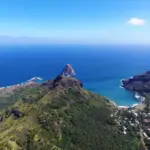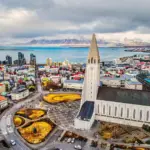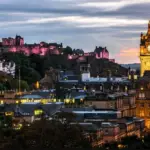Historical and Geographical Context

In the heart of the Italian peninsula lies a hidden treasure – the Republic of San Marino. Nestled high in the Apennine Mountains, surrounded by the beautiful landscape of the Italian region of Emilia-Romagna, this small republic is a living testament to a fascinating history.
Founded in ancient times, San Marino is considered one of the oldest continuously functioning nations in the world. Its unique geographical location provides stunning panoramic views of the surrounding valleys and the Adriatic Sea to the east.
San Marino's rich history dates back to the 4th century AD, when a Christian stonemason named Marinus fled to the mountains seeking refuge from the religious persecution of the Roman Empire. It was there that he established a small community that would become the foundation of the republic now known as San Marino.
Over the centuries, this land has resisted invasions and conquests by neighboring powers, maintaining its unparalleled independence and sovereignty. Although small in physical size, the Republic of San Marino has always exerted great symbolic and political influence.
Its republican and democratic tradition, combined with remarkable political stability, has become a model for other nations around the world. San Marino is a beacon of hope and perseverance, demonstrating that even the most modest nations can play an important role on the international stage.
The Importance of San Marino as a Republic
The Republic of San Marino plays a crucial role on the world stage as one of the few truly independent republics on the planet.. Your intricate history and its culture unique attract visitors from all over the world, eager to immerse themselves in their ancient traditions and witness the resilience of the San Marino people.
Furthermore, San Marino's political system is admired for its stability and emphasis on citizen participation. While many nations struggle with political instability and internal divisions, San Marino continues to thrive under the efficient functioning of its parliamentary democracy.
Citizens have an active voice in the decision-making process, promoting an inclusive and empowered societyAnother important factor is the republic's resilient economy.
Although small in scale, San Marino has managed to diversify its economic sectors over the years, focusing on tourism, financial services, and traditional manufacturing. The ability to adapt to global changes while preserving its cultural roots distinctive has been fundamental to the country's economic success.
The Legendary Foundation of the Republic of San Marino: An Impressive Story
The history of the Republic of San Marino is shrouded in legend and myth, which traces its origins. According to tradition, the republic was established around the fourth century AD by a Christian stonemason named Marinus, who fled to the mountains to escape persecution by Emperor Diocletian.
Marinus decided to establish a community based on principles of freedom and justice, inspired by Christian teachings. Over the centuries, this legendary foundation was passed down orally and became a symbol of San Marino's national identity.
Although official history is marked by the obscurity of the early years, there are more concrete historical records of events from the 13th century onward. However, the legend of the legendary founding remains an essential part of San Marino folklore and helps shape the unique narrative of this small country.
Political and Social Development Through the Centuries: A Lasting Legacy
The Republic of San Marino has developed over the centuries as a remarkable example of democratic self-government. From the outset, citizens have actively participated in political decision-making through the Grand and General Council.
Over the centuries, San Marino established itself as a parliamentary republic, where laws are discussed and voted on by elected representatives. This democratic tradition was crucial to preserving San Marino's independence and guaranteeing the civil and political rights of its citizens.
Social development was also a key aspect of San Marino's growth. High-quality public education has always been valued, enabling San Marino's citizens to become well-educated and engaged in the country's political and social life.

Resistance Against Invasions and Preservation of Independence: A Testimony of Strength
The Republic of San Marino has faced numerous threats throughout history, but has managed to resist with courage and determination. During the Napoleonic invasions of the 19th century, for example, San Marino maintained its independence through mutual respect between its local authorities and the French government. San Marino has also played an important role in providing refuge for those fleeing political persecution at various points in European history.
Its commitment to individual freedom and human rights made it a beacon of hope in dark times. Thanks to its steadfast resistance against foreign invaders, even during turbulent periods such as both world wars, San Marino has managed to preserve its independence to this day, becoming an inspiring example of resilience and determination for nations around the world.
Government system based on a parliamentary democracy
The Republic of San Marino adopts a governmental system based on parliamentary democracy. This means that power is exercised by the people through their elected representatives, ensuring citizen participation and a voice in the country's political decisions.
The Parliament, known as the State Congress, is composed of two chambers: the Grand and General Council (CGG) and the Council of Twelve (CdD). The CGG is made up of 60 members directly elected by the citizens of San Marino every five years.
These members represent different political parties and work collaboratively to create legislation and make important decisions for the country. The CGG has the power to pass laws, ratify international treaties, and elect Captains Regent.
Role of the Captain Regent and the Grand and General Council in decision-making
A unique aspect of San Marino's political structure is the role of the Captains Regent. Every six months, two Captains Regent are elected by the CGG to serve as the republic's heads of state for that period. This practice dates back to the 13th century and continues to this day.
The Captains Regent play an important role in government decision-making in San Marino. They preside over meetings of the CGG, implement laws passed by Parliament, and represent the republic at diplomatic events.
Although their functions are primarily ceremonial, they also have veto power in certain situations. The CGG, along with the Captains Regent, plays a crucial role in political decision-making in San Marino.
Parliament is responsible for passing legislation, discussing important national issues, and ensuring adequate representation of citizens. Through collaboration and debate within the CGG, decisions are made taking into account diverse perspectives and interests.

Emphasis on civic participation and citizen engagement
San Marino prides itself on its emphasis on civic participation and citizen involvement in the country's political affairs. In addition to regular elections to the CGG, there is a culture of active engagement among the population. San Marinoans are encouraged to express their opinions, contribute to the democratic process, and participate in non-governmental organizations (NGOs) that promote social well-being.
Furthermore, there are municipal councils in every San Marino community that help coordinate local activities and provide direct channels for citizens to participate in decisions that affect their daily lives. This inclusive approach strengthens the sense of community and allows everyone to have a voice in the country's development.
By combining a robust parliamentary democratic system, the significant role of the Captains Regent, and an emphasis on civic participation, San Marino builds a political structure that values citizen engagement and collective decision-making. This unique democratic approach contributes to the stability and continued progress of the world's oldest republic.
What to do in San Marino
San Marino is a small country located within Italy, and there are several things to do and see there. Here are some suggestions:
Visit the historic center: San Marino's historic center, known as Centro Storico, is a UNESCO World Heritage Site and features narrow streets, historic buildings, and stunning views of the surrounding countryside.
Explore the castles: San Marino is home to several castles, including Guaita, Cesta, and Montale castles. Visitors can explore the castles and learn about their history and importance.
Visit the Basilica di San Marino: This is the main church of San Marino and is dedicated to the country's patron saint. It boasts magnificent architecture and artwork.
Take the cable car up to Monte Titano: The cable car offers stunning views of San Marino and the surrounding countryside. At the top of Mount Titano, visitors can explore the three towers and enjoy the views.
Visit Piazza della Libertà: This is San Marino's main square, surrounded by historic buildings and shops. It's a great place to relax and people-watch.
Explore the museums: San Marino has several museums, including the Emigration Museum, the Museum of Ancient Weapons, and the Museum of Curiosities. These museums offer a glimpse into San Marino's history and culture.
Visit the Church of San Pietro: This is a church located near San Marino and features magnificent architecture and artwork.
Overall, San Marino offers a unique blend of history, culture and beauty natural, and there are many things to do and see for visitors.
Main Economic Sectors
San Marino has a diversified economy, with three main sectors driving its economic growth and development. Tourism is a crucial sector for the country, attracting thousands of visitors every year.
Thanks to its rich historical heritage, stunning landscapes, and charming atmosphere, San Marino offers a variety of tourist attractions, from its medieval castles to its fascinating museums. Furthermore, the country also excels in the financial services sector, with international banks and financial institutions establishing a presence in San Marino.
Financial services offered include wealth management, private banking, and corporate services. Traditional manufacturing is the third key economic sector in San Marino.
The country has a long tradition of producing high-quality artisanal products, such as hand-painted ceramics, blown glass, and unique jewelry. San Marino's craftsmanship is highly valued both domestically and internationally for its exceptional craftsmanship and authenticity.
Attractive Tax Benefits
One of the reasons why which San Marino has become a destination What's attractive to international companies is the country's favorable tax system. With low tax rates and advantageous tax benefits, companies have encouraged their presence in San Marino to maximize their profits and optimize their business strategy. Companies established in the republic enjoy competitive corporate taxation, as well as a stable legal and regulatory environment.
Tax benefits include exemptions from dividend and interest taxes, as well as significant reductions in profit taxes. These incentives attract companies in the financial, technology, and manufacturing sectors, seeking to take advantage of the economic advantages San Marino offers.
Economic Resilience Over the Years
San Marino has demonstrated remarkable economic resilience over the years, even during times of global crisis. Despite the economic hardships faced by the world at various times, the republic has managed to adapt and maintain its financial stability. A notable example was during the global financial crisis in 2008, when many countries struggled to recover.
San Marino managed to minimize the impact of the crisis thanks to its prudent management of public finances and the diversification of its economic activities. Furthermore, the country has actively sought international partnerships to further strengthen its economy.
Trade agreements with other nations have been established to boost foreign trade and expand San Marino's commercial horizons. This economic resilience is a testament to the country's wisdom in adopting strategic measures to ensure its continued growth in the face of global challenges.
San Marino Culture and Traditions Cultural Influences: A Mosaic of Heritage
San Marino, as an ancient republic with a rich history, boasts a unique culture that is a veritable mosaic of influences. Located in the heart of Italy, the nation has absorbed strong elements of Italian culture over the centuries.
The official language, Italian, is spoken by all San Marinoans, and the cuisine also shares many typical Italian dishes, such as fresh pasta and delicious risottos. Furthermore, the architecture of San Marino's towns and villages clearly reflects Italian Renaissance influences.
The presence of these Italian cultural influences becomes evident as you explore every narrow street and picturesque square in the country. However, these cultural influences extend beyond Italy's borders.
Due to its strategic location in the heart of Europe, San Marino has been exposed to diverse influences over the centuries. The region's inhabitants have roots dating back to the Etruscans and Romans; therefore, traces of this cultural heritage can be found in museums and archaeological sites throughout the country.
Furthermore, during the medieval period, San Marino was an important center for the artistic and intellectual movements of the time. Local Traditions: Preserving Historical Roots
San Marino keeps its local traditions alive, which are considered a cultural treasure. One of the best-known is the celebration of Saint Marino's Day, in honor of the republic's patron saint.
The celebration includes religious processions, street festivals, and performances of traditional San Marino music. These festivities provide a meaningful link between generations, allowing San Marino residents to connect with their historical heritage and pass it on to their youth.
Another important tradition is the periodic Games of the Ancient Maritime Republics. This sporting event brings together young athletes from sister cities like Naxos, Rhodes, and Dubrovnik to compete in a variety of traditional sports.
Additionally, cultural performances are organized during the games to highlight the unique traditions of each participating city.
Conclusion: A Valuable Cultural Heritage
San Marino is a small republic that preserves a valuable cultural heritage through the maintenance of its diverse traditions and cultural influences. Through its rich legacy history and its privileged geographical location, San Marino has remained a focal point for the diverse influences that have shaped its culture over the centuries.
Italian influences are evident in the language, cuisine, and architecture; however, the Etruscan, Roman, and medieval heritage is also appreciated through museums and local festivities. San Marino traditions help strengthen the collective identity of the people and preserve their historical roots.
The celebration of San Marino Day and the Games of the Ancient Maritime Republics are striking examples of the importance placed on maintaining these traditions. San Marino is a true jewel. cultural that deserves to be explored, appreciated and valued as a unique historical treasure in the heart of Europe.
Lucas Wanderlust has a tireless spirit of adventure, always seeking new travel experiences. Fascinated by the world and the possibility of exploring unknown destinations, he fell in love with the sense of freedom and self-discovery that traveling alone provides. With a backpack on his back and a heart open to the unknown, Lucas embarks on exciting journeys, where each destination becomes a unique chapter in his life story. He gives himself body and soul to the magic of solo travel, inspiring others to follow in his footsteps and discover themselves through adventure.







